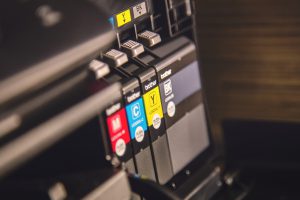 Firstly you have to ask yourself, what are my current and future printing needs? Do I print a lot of photos and images, or is it more text documents that I print?
Firstly you have to ask yourself, what are my current and future printing needs? Do I print a lot of photos and images, or is it more text documents that I print?
To gain a more simple understanding of why these simple questions are important to answer before choosing your next printer, lets go over the pros and cons of the different types of printers available on the market today. For this I will be reviewing two different types as most others such as Daisy Wheel, and Dot Matrix printers are outdated and have slow printing times as well as high maintenance costs, so for this I will mainly focus on Inkjet printers and Laser printers.
Mechanisms:
An Inkjet printer uses ink which it sprays onto paper out of a number of jets in a series of tiny dots as the printer head moves across the paper to recreate the text or image. Whereas Laser printers use toner which is made of electrically charged powder that gets fused with the paper fibres to produce an image.
Costs:
The initial cost of purchasing a printer can easily change your mind about whether to buy a Inkjet or a Laser printer, most of you will notice that Inkjets are far cheaper than their laser counterparts. However do not allow this initial saving lull you into thinking that this will reduce your printing costs, as Laser printers toner cartridges and the thermal transfer roll that is required to print onto a sheet of paper last far longer than the cartridges used in Inkjets. This means that the cost per-page is much lower for Laser printers, which makes them much more economical when it comes to printing off high numbers of documents, though Inkjets are cheaper for home use where the printing requirements may be low and varied. On top of this the cartridges within an Inkjet are filled with ink which is able to dry out, especially during the hotter seasons or hotter climates, this means that entire cartridges can end up being wasted when they aren’t being used, which is money down the drain, whereas Laser toner is a fine powder which understandably does not dry out.
Quality:
Since ink cartridges spill out tiny droplets of ink to print, the resolution is lower than that of laser toners. So, because of the high resolution factor, laser printers print better quality text and create precise fonts without fuzzy edges.If your printing needs include printing small fonts then Laser printers are the perfect choices as their fusing technology is more efficient when it comes to printing small text or fine print. Despite this increased quality with text printing, most Inkjets will produce a higher quality image or photo when printing, therefore you may want to consider acquiring an Inkjet if you are planning on printing high quality images. However if you are trying to get a number of images to printed it may be better to opt for a laser printer as the powder toner will not smudge as it is all ready dry when it leaves the heated roller, whereas another page rolling out on top of the first can easily cause smudging on Inkjet printouts as the ink requires a few seconds to dry.
Printing Speed:
Laser printers are way ahead in the race when it comes to printing speed. Laser printers are capable of handling multiple print jobs at one go, have faster processors and print engines that are capable of printing more than 35 pages per minute. The least expensive laser printer can print around 15 to 20 pages per minute, whereas a typical entry-level inkjet can manage around 10 pages per minute. The bottom line is that for large volumes of printing, laser printers emerge as the preferred choice and are more suited to general office use than inkjets. Many offices have one inkjet for colour printing and a laser for large scale text printing.